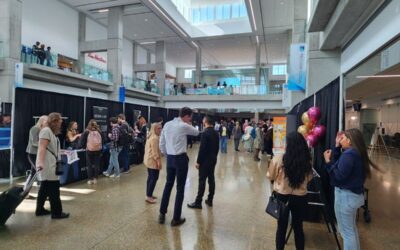One month after the introduction of NAIT’s mandatory tech fee, the school’s priorities are to address Wi-Fi concerns at the HP Centre and ensure that students get enough access to loanable equipment.
The $30 mandatory non-instructional fee (MNIF) announced last semester intends to help with NAIT’s operating costs regarding student access to technology. The budget outlines an upgraded IT help desk, improved Wi-Fi on campus and loanable equipment.
NAIT and NAITSA agreed to start with the HP Centre, as it’s a newer building and was already designed with Wi-Fi accessibility in mind. HP also got classroom upgrades this year, so financially, it made the most sense to focus their efforts on one building.
“What ended up happening for the money that is collected for the rest of this academic year is we have this agreement that they’ll all be focused on HP,” said Daryl Allenby, Associate Vice President (AVP) of Information Technology and Chief Information Officer (CIO) for NAIT. “There’s a great efficiency if we also then deploy the same contractors and procurement vehicles … to just do the entire space.”
The school added 60 laptops and 30 power banks to the existing library loanable equipment. According to Allenby, Dell G15 and G16 laptops were chosen to match DMIT program requirements since the preexisting equipment was “showing its age” and would have been “lacking” for student needs. The fee also covers additional support and salaries for staff working at the ITS help desk.
Keeping costs low
The introduction of the tech fee involved the formation of NAITSA’s MNIF committee. Although NAIT remains the primary decision-maker, NAITSA’s committee ensures that students have a say in how the school spends the money.
“We understand that everything is getting more expensive,” said Travis Luscombe, VP Internal for NAITSA. “As students ourselves, we are also incurring additional costs, and it’s something that we’re aware of.”
“We would like to see more predictability amongst improvements that are happening so we can provide opportunities for students and let them know what’s coming,” said Luscombe.
Budgets and bureaucracies
According to Allenby, the school’s focus areas rely heavily on the time and money budgeted for an institution of its size. Wi-Fi and internet access will likely always be a concern, but with the main campus sitting at just over 250,000 square metres and housing thousands of students, NAIT has to go through a lot of bureaucracy to plan and purchase items.
“There’s all this stuff going on that is totally invisible,” said Allenby. “Nobody sees it … but you have to deploy all that stuff to get a signal.”
Construction budgets often get a one-time investment of funds for all the technology and materials needed to maintain a building project. However, older areas in the 60-year-old campus have “legacy problems” that failed to account for technological progress, such as asbestos and lack of cable space. These concerns make it difficult to build better network infrastructure.
“The tech changes so fast,” Allenby added. “A technology that you didn’t even anticipate being critical, all of a sudden, is part of the everyday experience in life.”
With the HP Centre being newer, the AVP says that the building is “a little bit more predictable in terms of the evergreening requirement” needed to decide on the allocation of funds.
“Our intention is to have the HP Centre improvements around December winter break,” said Marina Bruno, VP Academic for NAITSA. “So for the next semester, students should be able to notice a difference in accordance to what we’ve been told.” If not, Allenby reassured that students should expect to see improvements later in Winter 2024.
The future of the fee itself is still in continued discussion between NAITSA and NAIT, but both parties asked that students share their concerns through help desks or by contacting NAITSA directly.





